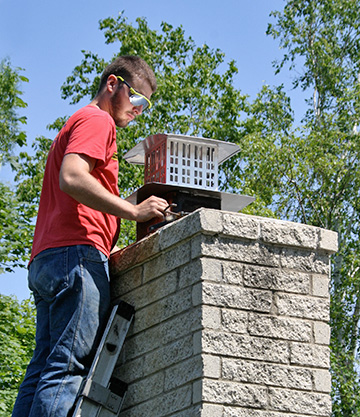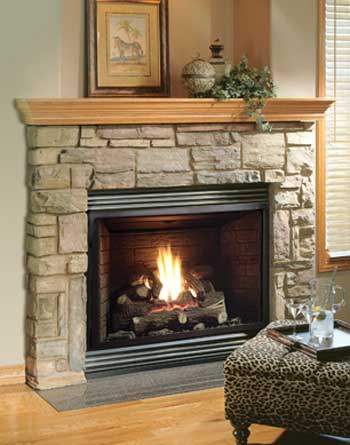Why Get A Chimney Cleaning?
Getting regular chimney cleanings and inspections are vital to the safety of your home and family. With chimney cleanings it helps eliminate the buildup of dangerous creosote and other debris that can accumulate with regular usage of the appliances that utilize the chimney, thus preventing potentially deadly and damaging chimney fires. Also, these regular cleanings and inspections help ensure that the integrity of your chimney is up to what it should be, and there is not a build up of damage.
Cleanings always include a 14 point inspection that is done to make sure that your chimney is safe from top to bottom. It is recommended that your chimney is cleaned and inspected every year, every 50 fires, or every face cord of wood which is 150 pieces of wood.
Fire Place Cleaning 14 Point Inspection
The 14 point inspection ensures that there is nothing that is missed when your chimney is getting serviced, and that you can enjoy your fireplace without worrying.
- Termination/Height/Clearance of your chimney.
- Proper raincap/spark arrestor.
- Chimney crowns/wash is free of cracks and proper over hang.
- Brick/Mortar joints are free of cracking and pitting.
- Flashing/Collar is properly sealed.
- Clay flue tiles are free of cracks, missing mortar or not shifted.
- Water or leaking from the crown, flashing, shoulders or brick itself.
- Smoke chamber is properly parged.
- Damper opens and closes efficiently and is free of warping and corrosion.
- Firebox brick are solid without missing mortar or shifted bricks.
- Ash Container and Ash Dump door are in proper working order.
- Proper Spark Screen and fireplace lintel is sealed properly.
- Gas log lighter and key valve are functioning properly and are free of corrosion and warping.
- Proper clearance of the hearth and mantel are present.

Furnace Chimney Cleanings
Your furnace, boiler, or hot water heater should get an annual cleaning and inspection as well. The entire chimney system should be cleaned and inspected, from the connector pipe which comes off your furnace and hot water heater to the top of the chimney. Also, to make sure the venting system is free of blockage and possible obstructions.
A typical furnace flue cleaning should include:
- Height and termination of the chimney.
- Rain cap or termination cap to allow proper ventilation.
- Chimney crown/Wash for cracks and proper overhang.
- Bricks of chimney for shaling, discoloration, and missing mortar joints
- Flashing of collar of chimney for proper seal.
- Clay flue liner for shifting or missing tiles.
- Water and efflorence throughout entire chimney.
- Appliance thimble, connector pipe and clean out door.
- Clean entire chimney from connector pipe, chimney flue and clean out door area.
Gas Fireplace Cleanings
Whether you have a Direct Vent or B-Vent Gas Fireplace you should get a cleaning/inspection at least once a year. Like any gas appliance in your home, your gas fireplaces should still be treated for safety and efficiency of your fireplace.
The steps to take for cleaning and inspection should include:
Glass: Remove glass and clean.
Pilot: Clean and check.
Gas Valve: Test for proper operation.
Thermocouple/Thermopile: Clean and check.
Gas Logs: Check for breakage and layout.
Wiring: Check for deterioration.
Thermostat/Remote: Check batteries and for proper operation.
Venting: Check for proper draft and configuration.
Also check the blower wheel and combustion chamber on certain models.
Chimney Inspections
There are three levels of chimney inspections that are done that have been outlined by The National Fire Protection Agency Standard NFPA211 that is used throughout the United States today.
Level 1
If your appliance or your venting system has not changed and you plan to use your system as you have in the past, then a Level 1 inspection is a minimum requirement. A Level 1 inspection is recommended for a chimney under continued service, under the same conditions, and with the continued use of the same appliance.
In a Level 1 inspection your chimney service technician should examine the portions of the chimney exterior, interior and accessible portions of the appliance and the chimney connection. Your technician will be looking for the basic soundness of the chimney structure and the flue as well as the basic appliance installation and connections. The technician will also verify the chimney is free of obstruction and combustible deposits.
Level 2
A Level 2 inspection is required when any changes are made to the system. Changes can include a change in the fuel type, changes to the shape of, or material in,the flue, or the replacement or addition of an appliance of a dissimilar type, input rating or efficiency. Additionally, a Level 2 inspection is required upon sale or transfer of a property or after an operation malfunction or external event that is likely to have caused damage to the chimney. Building fires, chimneys fires, seismic events as well as weather events are all indicators that this level of inspection is warranted.
There are no specialty tools required to open doors, panels, or coverings in performing a Level 2 inspection. A Level 2 inspection shall also include a visual inspection by video scanning or other means in order to examine the internal surfaces and joints of all flue liners incorporated within the chimney. No removal or destruction of permanently attached portions of the chimney or building structure or finish shall be required by a Level 2 inspection.
When a Level 1 or Level 2 inspection suggests a hidden hazard and the evaluation cannot be performed without special tools to access concealed areas of the chimney or flue, a Level 3 inspection is recommended. A Level 3 inspection addresses the proper construction and the condition of concealed portions of the chimney structure and the flue. Removal or destruction, as necessary, of permanently attached portions of the chimney or building structure will be required for the completion of a Level 3 inspection. A Level 2 inspection includes everything in a Level 1 inspection, plus the accessible portions of the chimney exterior and interior including attics, crawl spaces and basements. It will address proper clearances from combustibles in accessible locations.
Level 3
A Level 3 inspection includes all the areas and the items checked in a Level 1 and a Level 2 inspection, as well as the removal of certain components of the building or chimney where necessary.
Removal of components shall be required only when only when necessary to gain access to areas that are the subject of the inspection. When serious hazards are suspected, a Level 3 inspection may well be required to determine the condition of the chimney system.
|


